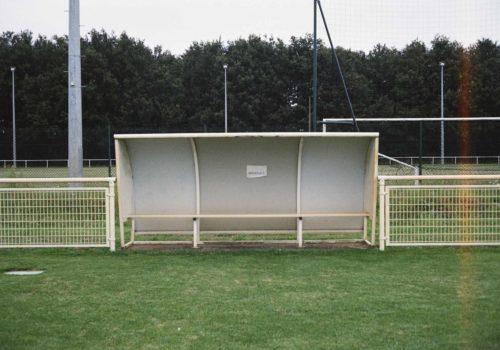In a long-term series that combines different photographic formats, Benjamin Rullier delicately highlights an all-women’s football club in a rural town of 800 inhabitants.
The starting point is simple: Benjamin Rullier wants to understand what is going on here, in Les Verchers-sur-Layon, in this rural, agricultural area, where a women’s football club has been established twenty years ago. So, what makes players from the other end of the department come to play here, drive two hours to train here twice a week? What does it mean to be a country club? What does the word commitment mean in a club where players, managers and volunteers are involved in keeping an atypical model alive and well?
“At the time we played in D2, we were considered to be the country girls and that was the truth. The image counts a lot. We all had to come in jogging suits, dressed in the same way, we had to conform to codes that didn’t suit us. But it was complicated, there were girls opposite who were semi-professionals, who trained all day. We tried to do three training sessions a week, as we were working or studying on the side. Today, it has become even more important. Amandine, AS Verchers football defender
The photographer chose to take a long time to get to know the club, the staff, the players, and to try to understand, without words, what makes the DNA of AS Verchers Foot. To carry out this project, he wanted to show fragments of what constitutes these Sunday afternoons of football, real moments of sport but also of encounters, of reunions for those who are attached to this club.
At one point, the season was very difficult and it was complicated for me. There were games where I wanted to leave the pitch, it was unbearable, I was ashamed of what we could produce, fed up with the number of goals we were getting. And yet I was running for every ball. I was torn between the realism of our level and my fighting spirit, which always took over. I thought: maybe we could do something. And anyway, even if we lose, I’ll just give it all until the 90th minute.
Sport and football photography is not the main subject. Benjamin Rullier is more interested in the scenes, the objects, the faces, the emotions, what is transmitted before, during and after the match. We observe in turn legs feverishly waiting to enter the field, arms waving on the bench, a forgotten ball across the wasteland, bodies going into contact, into battle, faces marked after the match, and we understand the commitment of the players and supporters gathered along the barriers or on the small earthen mound.
The question of the gaze is essential. By working with different cameras, different formats, he offers different points of view, different axes on this project: portraits with a Pentax 6×7 (medium format film) taken at the end of the match, scenes around the field, among the spectators, captured with a Canon QL17 GIII (compact rangefinder), and what happens on the field, with a Fujifilm XH-1 (digital hybrid).
Finding the right distance, isolating the bodies, freezing the scenes delicately, this is the recipe that Benjamin Rullier tries to put in place to bring the spectators to look at this club, hidden in the back of a forest, at the exit of a village through which few people pass.
I often leave at 6.30 pm and come back at 10.30 pm. Because Les Verchers is the club of my heart, the family club. There is a competition, of course, but it has always had a good atmosphere. I don’t know if I could find that anywhere else but here
Benjamin Rullier’s digital photographs were all taken with a Fujifilm XH-1 and the Viltrox 90mm f/2, Fujifilm XF 56mm f/1.2 and XF 200mm f/2 lenses, whose luminosity and depth of field allow the subject to be isolated, to freeze the movement. They were purchased on MPB.com, a company that buys and resells second-hand photographic equipment that has been tested and verified by specialists.
















